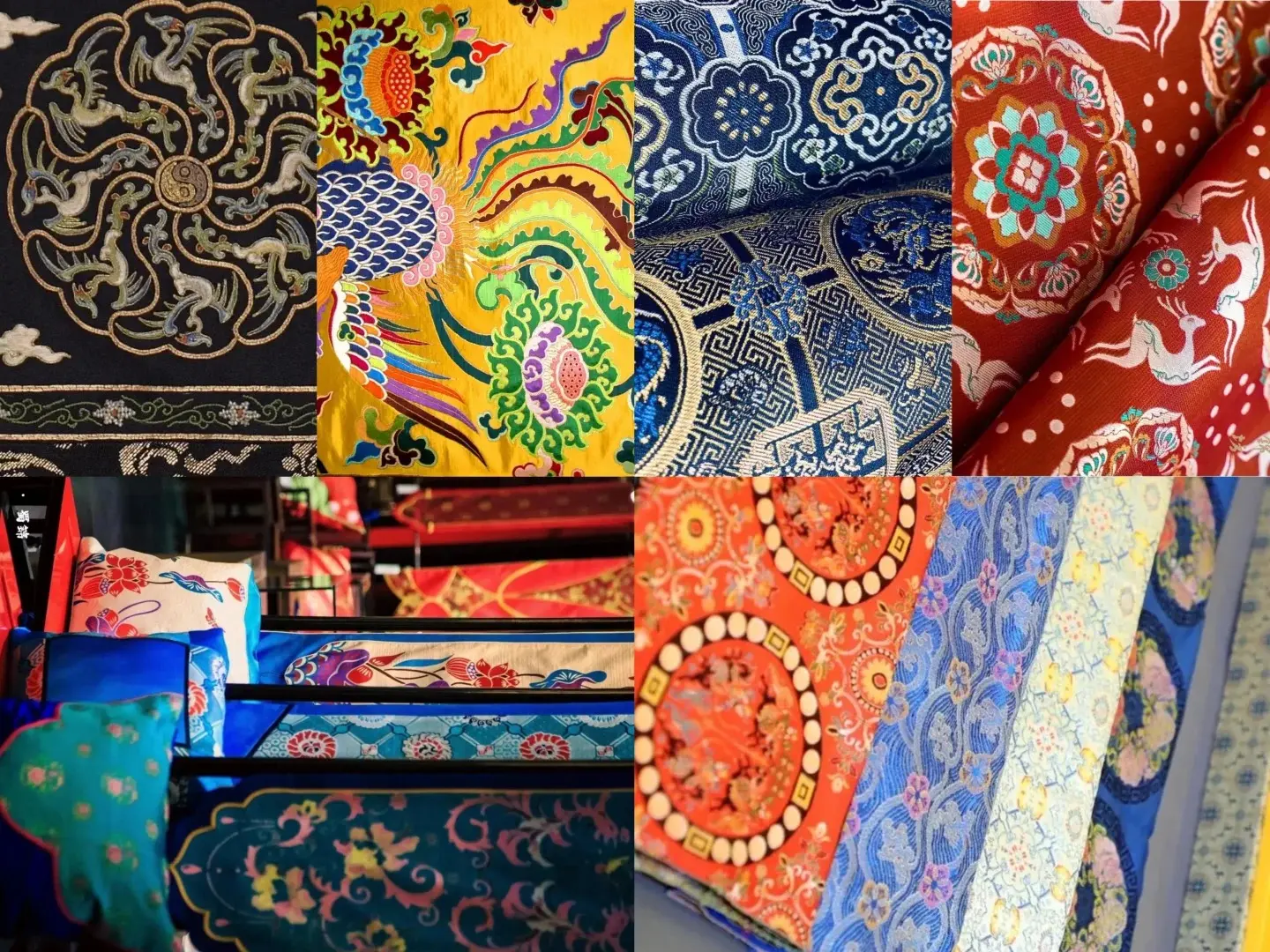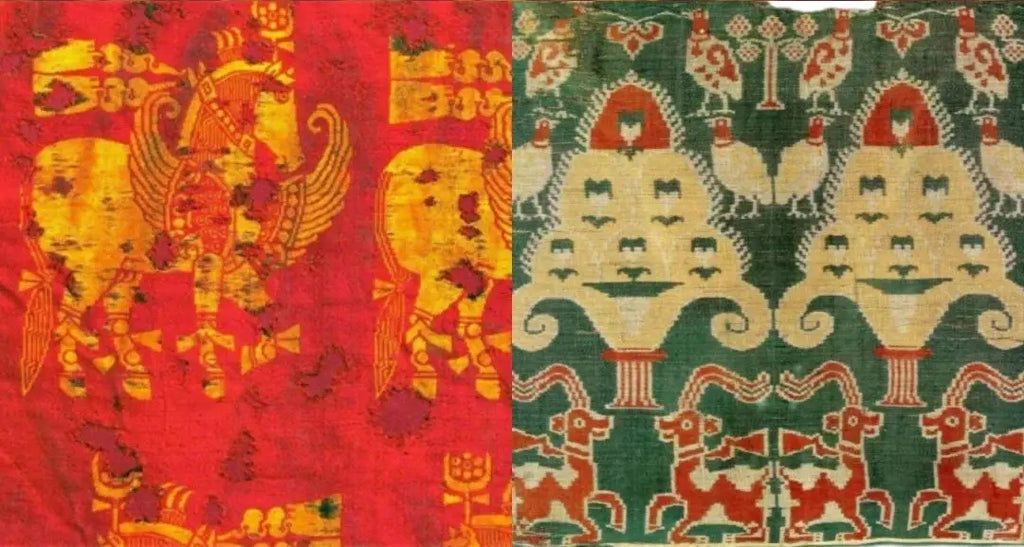History of Chinese Brocade(Zhijin): The Pinnacle of Silk Culture

Brocade, or zhijin, refers to a type of fabric woven with dyed colored warp and weft threads to create patterns using jacquard weaving techniques. Brocade is usually made on a draw loom and is known for its ornate and decorative appearance. China is the earliest producer of brocade(zhijin) in the world, and Chinese Yun brocade(Yunjin) is regarded as the finest representative of Chinese brocades(zhijin).

What is Chinese Brocade? The Pinnacle of Silk Culture
Chinese brocade refers to woven textiles adorned with intricate patterns, crafted from dyed colored silk threads, and sometimes enhanced with gold and silver threads. The name “brocade(zhijin)” comes from the shimmering patterns woven with these luxurious threads. Brocade uses jacquard weaving techniques to create complex designs, embodying the highest level of ancient Chinese textile craftsmanship.

7 Major Types of Chinese Brocades
Nanjing Yunjin(Yun Brocade)
An imperial staple and the highest embodiment of Chinese brocade artistry. In 2009, the Nanjing Yunjin(Yun Brocade) weaving technique was inscribed on the UNESCO Representative List of the Intangible Cultural Heritage of Humanity.

Chengdu Shujin(Shu Brocade)
Originating during the Warring States period, with a history stretching over 2,500 years. In the Han Dynasty, official workshops and brocade offices were established to weave brocade for the imperial court. After Emperor Wu of the Western Han Dynasty opened the Silk Road, Chinese brocade traveled to Persia (modern Iran), Rome, and beyond.

Suzhou Songjin(Song Brocade)
Developed during the Song dynasty, about 746 years ago, derived from Tang dynasty brocades. Song brocade was primarily used for mounting paintings and calligraphy, as well as for court garments. It is renowned for its bright colors, exquisite patterns, and supple-yet-firm texture, earning the title “Crown of Chinese Brocades”.
Guangxi Zhuangjin(Zhuang Brocade)
A traditional handwoven Zhuang ethnic brocade, probably originating in the Han dynasty. Its patterns draw inspiration from daily life, nature, and Zhuang totem worship, featuring bold geometric and animal motifs with striking artistic flair.
Click to see zhuang brocade handbags
Hainan LIjin(Li Brocade)
Known as a “living fossil” of the textile industry, Li brocade boasts a history of over 3,000 years and is one of the oldest cotton weaving techniques in the world. The Li people, having no written language, used brocade as a “living chronicle” to vividly record life and customs. Since the Han dynasty, Li brocade was offered as tribute; its primitive patterns possess rich symbolism.

Xiangxi Tujia jin(Tujia Brocade)
With a history spanning more than 1,500 years, Xiangxi Tujia brocade is most representative in the Western Hunan area, known as xipu lan ka.

Yunnan Daijin(Dai Brocade)
A folk hand-woven textile unique to the Dai ethnic group in Yunnan. Its motifs are inspired by everyday life and religious beliefs, embodying unique ethnic characteristics.

7,000-Year Brief History of Chinese Brocade
China’s cultivation of silkworms, silk reeling, and jacquard weaving date back thousands of years. Silk products have developed for over 7,000 years.


Neolithic Age:
- Yangshao Culture: Silk threads made from silkworms have been discovered.
- Hemudu Site, Zhejiang: Discovery of an engraved silkworm.
- Qianshanyang Site: Findings of woven silk fragments.

Shang Dynasty:
More woven silk artifacts and documentary evidence have been discovered.

Zhou-Han Dynasties:
- Zhou Dynasty: Discovery of brocade, brilliant multicolored patterns.
- Zhanguo: Discovery of Shu brocade.
- Han Dynasty: Establishment of official workshops; Zhang Qian’s opening of the Silk Road led to Chinese brocade reaching Western territories.

Three Kingdoms to Tang Dynasty:
- San guo: Shu brocade came to the fore.
- Dongjin: Establishment of the Brocade Office in Nanjing, marking the official rise of Nanjing Yunjin brocade.
- Tang Dynasty: Shu brocade reached its height; weaving techniques evolved from warp-faced to weft-faced brocade.

Song-Yuan Period :
- Song Dynasty: Emergence of Song brocade.
- Yuan Dynasty: Jiangnan region became a silk weaving center; Yunjin brocade became imperial standard. Marco Polo’s account describes the booming silk trade in Hangzhou.

Ming-Qing Period:
- A time of prosperity for brocade production, centered in Nanjing and Suzhou. Yunjin became the standard for imperial dress.

Brocade and the Silk Road: China’s Luxurious Gifts to the World
For over two millennia since the Western Han—if not earlier—Chinese brocade, the most exquisite part of silk culture, journeyed with camel caravans on the land Silk Road and with sea-going vessels on the Maritime Silk Road to the far reaches of the world. These dazzling and unprecedented textiles captivated the Western world, fostering fascination with the distant and mysterious East.


Conclusion
Chinese brocade, with its rich history, exquisite craftsmanship, and profound cultural symbolism, stands as a testament to the artistry and ingenuity of Chinese civilization. Today, Sinocultural innovatively combines traditional brocade craftsmanship with modern bag designs, creating unique brocade handbags that seamlessly integrate into contemporary lifestyles.
From ancient artifacts to UNESCO recognition, these treasured textiles continue to inspire admiration both in China and around the globe, bridging history, culture, and art through every shimmering thread.
Special thanks
The content of this article was provided by Ms. Liu, a descendant of the "Wu Jia Zhang Fang", and re-edited by sinocultural.
- Education
- Course
- Books
- Drawing
- Question
- Film
- Fitness
- Food
- Games
- Gardening
- Health
- Home
- Literature
- Music
- Networking
- Other
- Programming
- Religion
- Shopping
- Sports
- Curriculm
- Wellness




